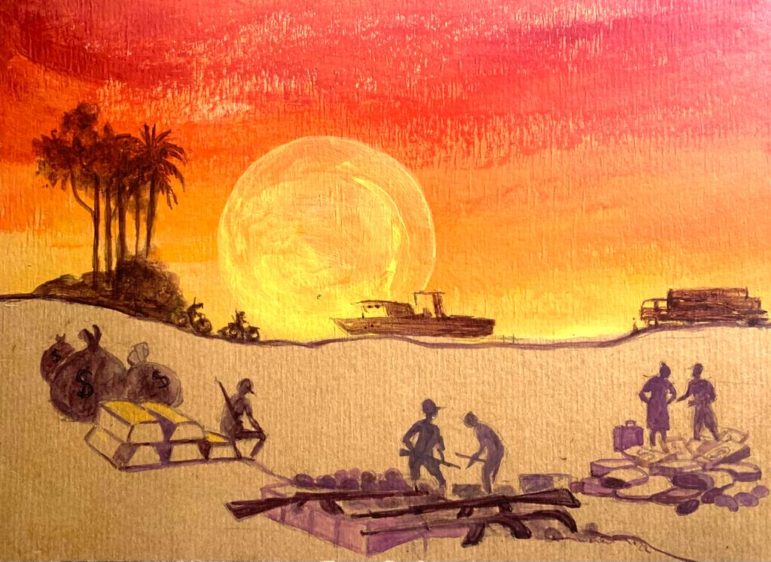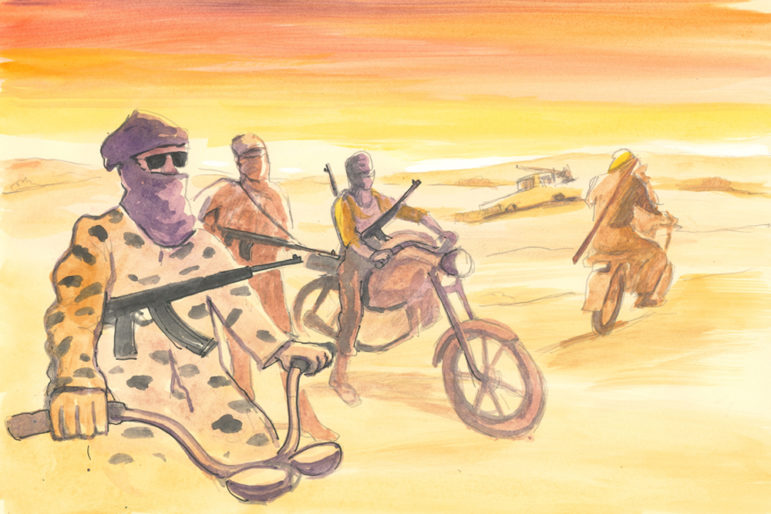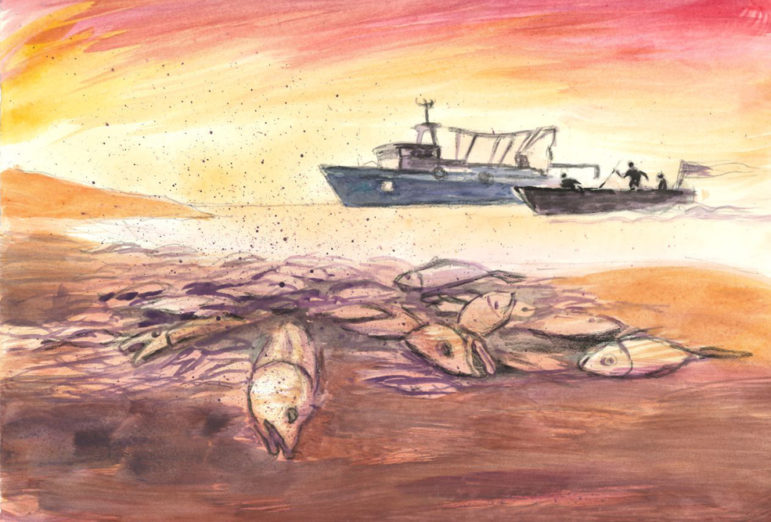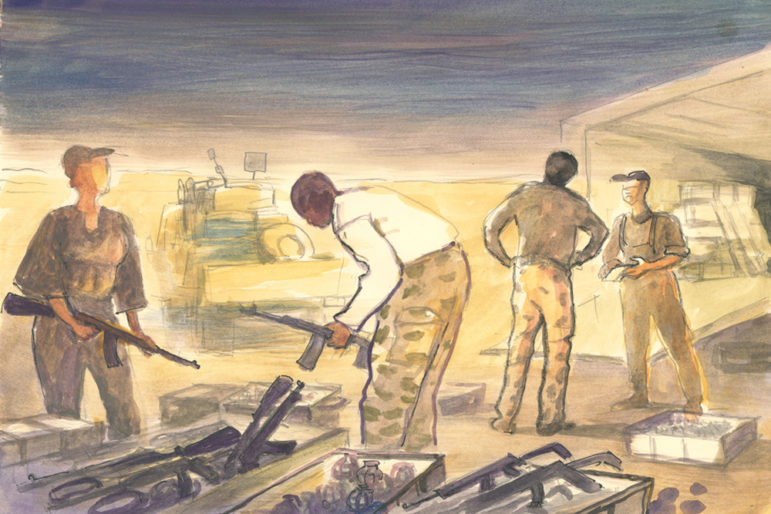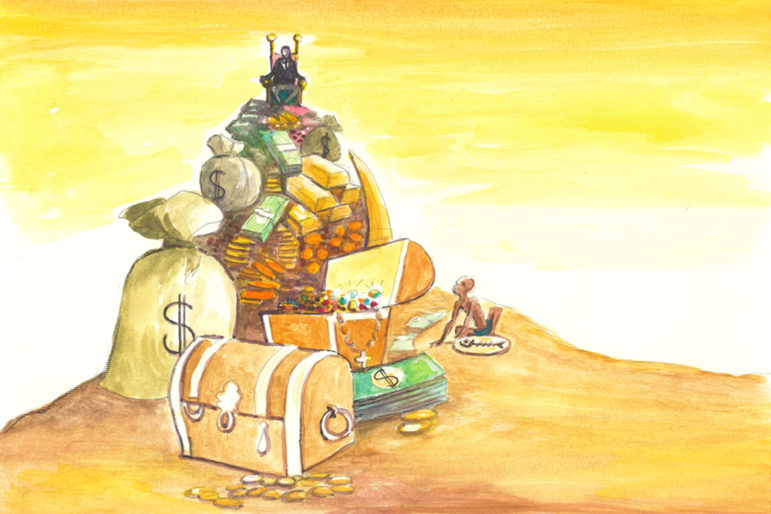

Illustration: Dominique Mwankumi for GIJN
Guide to Investigating Organized Crime in Africa: Chapter 6 — Drug Trafficking
Read this article in
Guide Resource
Guide to Investigating Organized Crime in Africa
Chapter Guide Resource
Guide to Investigating Organized Crime in Africa — Introduction
Chapter Guide Resource
Guide to Investigating Organized Crime in Africa: Chapter 1 — Environmental Crimes
Chapter Guide Resource
Guide to Investigating Organized Crime in Africa: Chapter 2 — Terrorist and Militia Groups
Chapter Guide Resource
Guide to Investigating Organized Crime in Africa: Chapter 3 — Crimes on the Oceans
Chapter Guide Resource
Guide to Investigating Organized Crime in Africa: Chapter 4 — Arms Trafficking
Chapter Guide Resource
Guide to Investigating Organized Crime in Africa: Chapter 5 — Natural Resources Theft
Chapter Guide Resource
Guide to Investigating Organized Crime in Africa: Chapter 6 — Drug Trafficking
Chapter Guide Resource
Guide to Investigating Organized Crime in Africa: Chapter 7 — Financial Crimes
Chapter Guide Resource
Guide to Investigating Organized Crime in Africa: Chapter 8 — Kleptocracies
Chapter Guide Resource
Guide to Investigating Organized Crime in Africa: Chapter 9 — Other Crimes
The illicit drug industry is lucrative and growing across the continent. Africa serves as both a major transshipment center and, increasingly, a homegrown market, with an annual trade in the billions of dollars. Drugs of choice run the full spectrum, from cocaine and methamphetamine to synthetics and pharmaceuticals. The continent’s relatively young population and its rapid growth will fuel a 38% increase in drug users between 2018 and 2030, according to estimates by the United Nations Office on Drugs and Crime (UNODC).
Record-breaking seizures in 2021 and 2022 point to a drug trafficking boom across the continent. Especially hard hit is West Africa, where the volume of narcotics trafficking is thought to be above 50 metric tons annually. Authorities in Nigeria, the continent’s largest economy, confiscated 1.8 tons of cocaine worth US$278 million from a single warehouse in Lagos in September 2022, in the largest drug raid in the country’s history. Yet that seizure is estimated at just 2% of what moves through the region annually.
Africa, which formerly played a minor role in the transnational illicit drug trade, is quickly developing into a hub for transshipments. Drugs are transiting African countries for later sale in profitable Western European markets — arriving through Africa’s ports, airports, and desert. So corrupting is the transshipment business today that Guinea-Bissau has been branded a narco-state.
The impacts are far-reaching. Drug trafficking undermines economic development and can destabilize entire countries, the UN Security Council has warned. It has the potential to incite brutal gang wars, fuels corruption, puts added pressure on healthcare systems, and strains the response from authorities (as witnessed in South Africa).
Seizure data, according to the 2022 UN World Drug Report, shows Africa with increased levels of cocaine trafficking, among other drugs. Between 2019 and 2022, at least 57 metric tons of cocaine were found in or on their way to West Africa.

Significant individual cocaine seizures in transit regions or emerging cocaine markets, Africa and Asia, 2020-2021. Source: UNODC, Drugs Monitoring Platform. Image: UNODC
Investigating drug trafficking, therefore, requires journalists to go beyond daily events and police reports. It not only requires uncovering wrongdoing by criminals and their networks but also the individuals and institutions that enable them. Take, for example, a local mayor in Niger who was arrested with more than 200 kilograms of cocaine in his vehicle. Investigating such an event involves unraveling the mayor’s network by digging up what is secret or hidden. It involves examining the policies of government, companies and other organizations, if any, that enabled the criminal enterprise.
Such reporting can be a dangerous affair, however. Journalists may be physically attacked and intimidated. Drug traffickers may have political connections, ties to police, and enough resources to harass reporters with lawsuits and private investigators.
Tips and Tools
Finding data. Start with international organizations such as the UN Office on Drugs and Crime (UNODC). In its reports you’ll find the latest on trends, seizures, price, and purity, as well as data on drug production. You can filter annual drug seizure reports here, by country, drug, region, and subregion, going back to 1990. Look for drug traffickers on INTERPOL’s Red Notices; you can filter by country of origin or the country they’re wanted by.
Diversify your sources. This may sound like standard investigative journalism practice, but it’s important to develop a wide range of sources. Verifying their credibility, and analyzing the data you have obtained will help build a framework of critical information that will translate into a strong story.
Be cautious of official sources and figures. Officials may hype the threat (or downplay it), so spend time verifying what they report. Guinea-Bissau journalist Allen Yéro Embalo, correspondent for AFP and Radio France International, who has investigated drug cartels for years, recommends that journalists develop trusting relationships with law enforcement sources at various levels in their countries, such as Nigeria’s National Drug Law Enforcement Agency, Kenya’s Anti Narcotics Unit, or South Africa’s Directorate for Priority Crime Investigation. Often, good tips will come from these sources.
But Embalo also warns that reporters should be wary when reading drug seizure figures; these can be faked. “Sometimes the packages being burned on camera may just be dummy packages of other products while the real drugs are diverted elsewhere,” he warns.
Monitor other types of trafficking tied to drugs. Niger journalist Moussa Aksar, president of Norbert Zongo Cell for Investigative Journalism in West Africa (CENOZO), suggests looking at trafficking networks generally: “Monitor what is happening in other types of trafficking, like tobacco smuggling in the Sahel region or other illegal products.”
Keep an eye on both the suppliers and the consumers. If there is an illicit market for drugs, it is because there are suppliers and, obviously, consumers. Monitoring the pattern of drug consumption can provide data, and trends, and leads to investigations. Former addicts may agree to provide you with information on the supply chain. Local branches of the International Society of Substance Use Prevention and Treatment Professionals are emerging on the continent and can be important sources for reporting on trends in consumption, addiction, or recovery.
Collaborate. Investigating drug trafficking can be a slow and expensive affair. Working jointly can spread the financial burden and the associated risks. For example, you may be able to investigate and publish stories that traditional media outlets will not touch due to vested interests like fear of advertising boycotts or retribution. Journalists from source countries in Latin America, and from destination countries in Europe, may be eager to collaborate, as are colleagues in neighboring states. Embalo, of Guinea-Bissau, has worked with journalists from Liberia and Nigeria in his drug investigations.
Follow the money. The narcotics business cannot survive without moving huge amounts of money — for manufacture, distribution, laundering, and more. It’s vital to understand the financial base of this underground industry. Take advantage of free resources like manuals on tracking illegal financial flows and training sessions on illicit finance. Regional organizations such as The Inter-Governmental Action Group against Money Laundering in West Africa (GIABA) can provide training, experts, or documentation on the illicit economy in your area.
Look for the trails. Organized criminal networks like drug traffickers use creative accounting to make the income proceeds of organized crime activity look legitimate. Analyzing records like income statements to determine the presence of unexplained income can open doors to exposing drug trafficking and its beneficiaries. Look for major discrepancies between reported income and the level of expenditures to suggest unlawful income.
You can follow the money with the use of the investigative data tool OCCRP Aleph. Search through information and records from earlier investigations, authoritative sources, and databases that have been scraped. Aleph offers access to in-depth information about people of interest, businesses, financial activities, and other topics.
Use Open Corporates, a free and easy-to-navigate database of companies. It’s a good start when investigating a suspected individual and trying to link them to the companies that move their money. Another free global database to use is Open Sanctions, with the latest sanctions lists of politically exposed people and other data about people of public interest. You can use it to do background checks on individuals and companies of interest that were previously flagged for illegal conduct and conflicts of interest.
Other local or regional actors in the fight against drugs are worth checking. Some can be found among the Africa members of the International Drug Policy Consortium (IDPC).
Technology is key. Drug trafficking is adapting to modern technology, and given the massive resources at the disposal of narco-traffickers, they can use online platforms to communicate and plan their activities secretly by maintaining anonymity. You should take advantage of these these online tools to augment your ability to sort through data and identify clues.
Case Studies
Sweet Sweet Codeine: Nigeria’s Cough Syrup Crisis, BBC News Africa (2018)
Ruona Meyer and Adejuwon Soyinka investigate the codeine cough syrup crisis afflicting millions of young people in Nigeria. Through courageous undercover filming, the team exposed the illegal practices of what appeared to be respectable pharmacies and was able to reveal the corruption at its root. After the documentary aired, Nigeria banned the production and import of codeine cough medication.
Hezbollah in Africa: Forgotten Link in Cocaine Trafficking to Antwerp, Rotterdam, Premium Times (2021)
Belgian investigative journalist Daan Bauwens teamed up with Nigerian Nicholas Ibekwe to offer insights into a key drug smuggling route and trace back how the proceeds were channeled, some of it ending up financing a brutal conflict on another continent. The trail leads from poor, desperate people trying to survive, to a corrupt bureaucracy willing to look the other way, to a designated terrorist organization running a lucrative criminal enterprise.
The Hardest-Working Drug Gang You’ve Never Heard Of, OCCRP (2020)
From Poland to South America to the busiest shipping terminal in sub-Saharan Africa, South Africa’s Durban Harbour, OCCRP paints a portrait of Group America, one of the world’s least known but most active international narcotics syndicates. Stevan Dojčinović and Pavla Holcová obtained thousands of pages of confidential police reports, interviewed law enforcement officials, and even visited the gang’s boss in a Peruvian prison.
How Your Coke Drink Is Screwing up West Africa, Vice (2020)
In this series, journalists Nicholas Ibekwe and Daan Bauwens offer an inside look at the drug trafficking route stretching from South America to Europe via West Africa. They traced the trail of the Ndrangheta, Italy’s notorious mafia syndicates, to the Côte d’Ivoire transit port of Abidjan, a crucial link in the gang’s shipments to Italy and Belgium. And they revealed the lengths to which Colombian drug cartels went to successfully co-opt African leaders.
Burkina Faso, Mali, Niger: On the Criminal Drug Routes in the Sahel, CENOZO (2022)
Drugs of all kinds are trafficked through Burkina Faso, Mali, and Niger on their way to Europe. This traffic, which is encouraged by open borders and a lack of authority, feeds the Sahel’s criminal problem. The investigation offers a comprehensive picture of drug trafficking in the area, from drug trafficking routes to how illicit money from the trade is fueling terrorism.
Table of Contents | Introduction | Chapter 1 | Chapter 2 | Chapter 3 | Chapter 4 | Chapter 5 | Chapter 7 | Chapter 8 | Chapter 9
Additional Resources
Reporter’s Guide to Investigating Organized Crime — Drug Trafficking
GIJN Webinar: Investigating Organized Crime in Sub-Saharan Africa
Using Public Information Requests to Investigate Drug Trafficking
 Stephen Kafeero is a journalist from Entebbe, Uganda. He is a 2020 Open Society Foundation scholar for Investigative Journalism. He has written for a variety of publications including the Daily Monitor, Quartz, and New Frame. He has interests in good governance, democracy, human rights, the media, and the law.
Stephen Kafeero is a journalist from Entebbe, Uganda. He is a 2020 Open Society Foundation scholar for Investigative Journalism. He has written for a variety of publications including the Daily Monitor, Quartz, and New Frame. He has interests in good governance, democracy, human rights, the media, and the law.

